#BkMMutDig
Photo
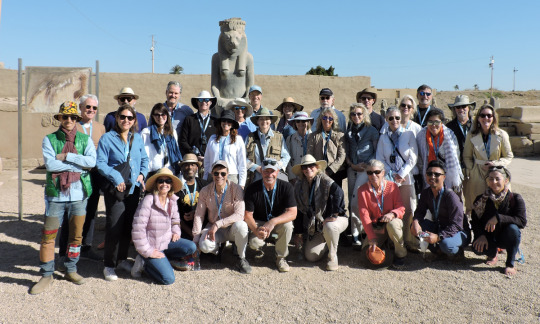
We began work on January 28, but the highlight of this week was the January 31 visit to the site by Anne Pasternak, the Brooklyn Museum Director, and members of the Museum’s Board of Governors. We were thrilled to be able to show them the site where Brooklyn has worked for the past 40+ years. We hope they enjoyed their visit.

As promised last week, here are the members of our team. Our foreman again this year is Abdel Aziz Farouk Sharid (left). He and our inspector, Haitham Mohamed Sa’ad el-Din are discussing the season’s work. The Supreme Council of Antiquities (SCA) assigns an inspector to every expedition to act as liaison with the SCA and help facilitate the work. We are happy to have Haitham with us this season.

Besides Abdel Aziz, the Qufti who working with us this year are Abdel Aziz’s brother Ayman Farouk Sharid (center), the foreman for the Johns Hopkins University expedition who works with us when Hopkins isn’t in the field; and Mamdouh Kamil, who has worked with us for many seasons. All are from the village of Quft (ancient Coptos), which has a long tradition of archaeology going back to the late 19th century. Ayman and Abdel Aziz are the sons of one of the great Egyptian archaeologists, the late Farouk Sharid Mohamed, who was a beloved friend and treasured colleague. His sons are worthy successors to him.

You are looking northwest at the first court of Temple A, which stands northeast of the Mut Temple. We are working in two areas of the court this year. In 2019 we were able to confirm that that the row of limestone features on the court’s south side were sphinx bases. This season we want to see if there are remains of corresponding bases on the north side (right). We are also clearing the corridor between the south colonnade and the south wall of the court (left).

By the end of the week (February 2) the results in the north square were equivocal. Looking north, you can see an area of decayed limestone on the right side of the square that might be the remains of a sphinx base. On February 1, Mamdouh uncovered the round, dark feature to the left of the “sphinx base” that might be a tree hole. Sphinx avenues often had trees planted between the sculptures.

The work on the corridor was more productive. By the middle of the week Ayman had cleared a mass of broken stone and revealed the lowest course of the court’s south wall (left) and the footing of the temple’s 2nd Pylon. Both sit on a sand foundation that you can see below the blocks of stone. It was common to use sand in the foundations to level out uneven ground.

On February 1 our Dutch colleague, Jacobus (Jaap) van Dijk joined us for another season. First thing on the morning of February 2, Ayman called us over to show us an interesting find: a large relief-decorated block. Jaap immediately got down to have a look.

The block has a beautifully carved relief of Amun that clearly is Thutmoside in style, that is, from the reign of Hatshepsut and/or Thutmosis III, of the mid-15th century BC. What makes it particularly interesting is the small, shallowly carved graffito of a God’s Wife of Amun facing the Amun and dating stylistically to Dynasty 25 or 26, about 700 years after the god’s face was carved. God’s Wives of Amun were priestesses, usually the sisters or daughters of kings, who wielded great political power in the Third Intermediate Period and later.
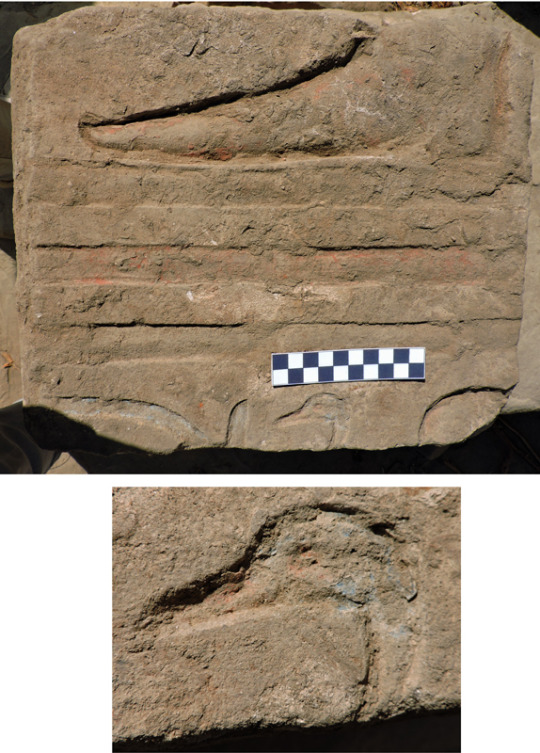
Just west of the Amun block was smaller cube of stone with a sunk relief depiction of a man’s foot on base lines with the top of a cartouche and the “son of Re” title below. The style of the foot (very long) and the vertical element of the cartouche date it to the reign of Akhenaten. It probably came originally from his temple in East Karnak, built before the king moved the capital to Amarna. The artist paid attention to detail when painting the relief, painting the head of the goose (“son”) blue but its beak and eye red. The Brooklyn Museum has an interesting group of Amarna Period reliefs showing a pastoral scene.

By the end of the week Ayman and his crew had cleared the bases of the first 3 columns of the colonnade, working from west to east. The blocks of the bases are large: 70 cm by 125 cm and almost 100 cm thick.
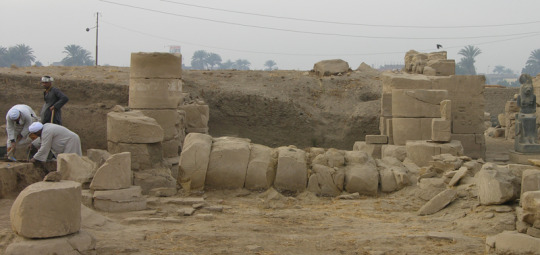
We are also planning on restoring 2 fallen columns in the colonnaded porches in front of the Mut Temple. The one in the East Porch is shown here as it was found in 1979. Work hasn’t started on these yet; there will be more about the restoration next week.
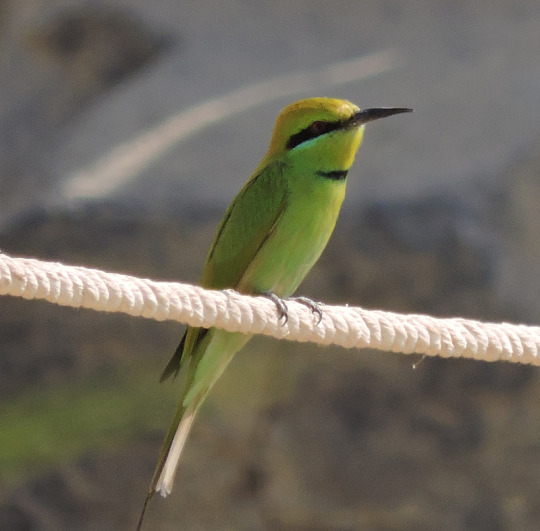
One of our favorite birds is the tiny, bright bee eater, so called because it catches insects in mid-air. This is the first we’ve seen this season.

An unusual cloud formation seen at sunset one night. Angels? Extraterrestrials?
Posted by Richard Fazzini and Mary McKercher
#BkMMutDig#MutDig#Mut#temple#Egypt#excavation#BkMEgyptianArt#egyptian art#egyptian#amarna period#Akhenaten#Thutmoside#archaeology#Brooklyn Museum#brooklyn#museum#art
223 notes
·
View notes
Photo

Imagine waking up to this view every morning. This picture was taken at sunrise on February 15. The view of the Theban cliffs never gets old.
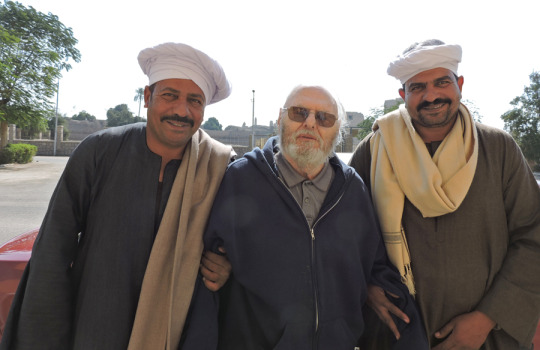
This is something of a bittersweet post. This is our last season in the field, which means we must say goodbye to Ayman and Abdel Aziz. We have known them since they were children and have worked with them as adults for many years. We treasure them and their friendship greatly and regret that we will likely never see them again. Partings are hard.

We had to cut this season short because of health problems, but we managed to accomplish what we set out to do. This photo from the precinct’s enclosure wall shows Temple A’s First Court with the north square with its sphinx bases in the foreground and the colonnade along the south side of the court in the rear
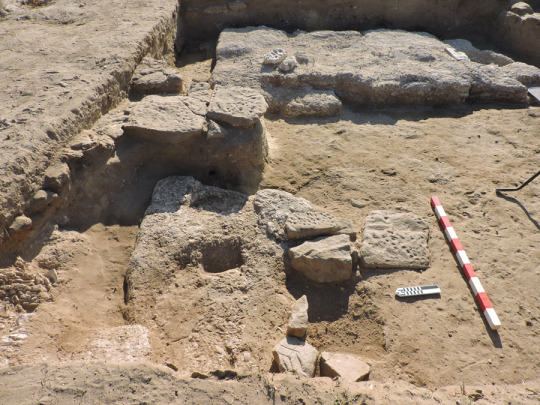
We now have not one but two sphinx bases. You are looking east across what is left of the second base in the northwest corner of the square. Only the northern part of the base remains; the rest is completely gone. The better-preserved base is in the background. The discovery of this second base is even more confirmation that there was once a row of sphinxes on the north side of the court as on the south.

Something of a surprise was the discovery of part of the original paving along the north and east sides of the larger base. It took Mamdouh great patience and skill to bring this paving to light.

Ayman went as far as he could in the corridor on the south side of the court. In addition to the usual broken stone, it is clear that the south wall of the court collapsed at this point, with large blocks now completely blocking the corridor

This view of the corridor, looking east, was taken on February 14, our second last day at the site. The columns and their massive limestone and sandstone foundations are now clear, although we did not find any trace of the corridor’s original flooring, which had been removed in antiquity.

Unlike sandstone, which can decay into sand but is otherwise pretty stable, limestone has a tendency to fracture. When we removed the beautiful limestone block with the head of Amun and the God’s Wife of Amun, it broke to pieces. An Egyptian conservator is painstakingly putting it back together (the block is upside down). He hadn’t finished by the time we left, but Abdel Aziz has promised a photo of the finished restoration that we can show in the next post
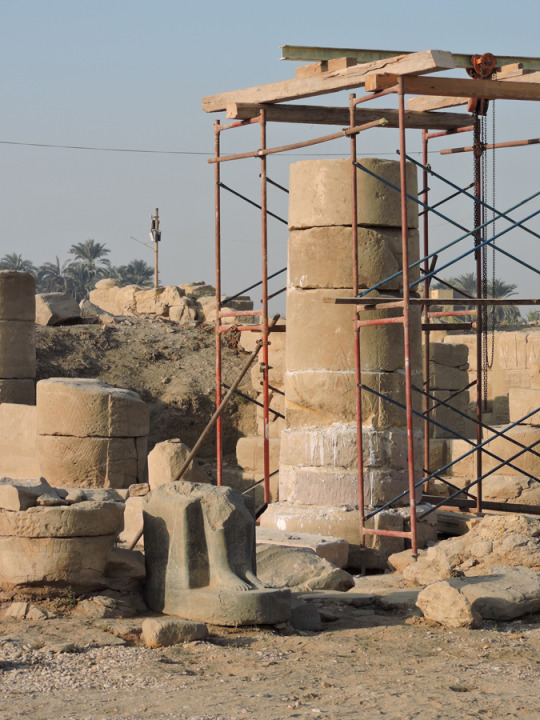
This is the east, better-preserved side of the column in the East Porch at the end of the season.

The other side of the column was much more damaged, so the restorers have been filling in the missing portions with a cement mixture. The man on the scaffold is roughing up the surface so that the finishing coat can be applied. Once that’s done, all the drips will be cleaned up.

The second column to be restored this season was found when we cleared the Mut Temple’s West Porch in 2005. We haven’t talked about it yet as it is a more complicated project that couldn’t begin until the repairs to the east column were well underway. As you can see, it, too, collapsed to the west, but what remained standing has been seriously damaged by flooding, which causes sandstone to decay. The top block has turned mostly to sand, and the column base is very decayed as well.
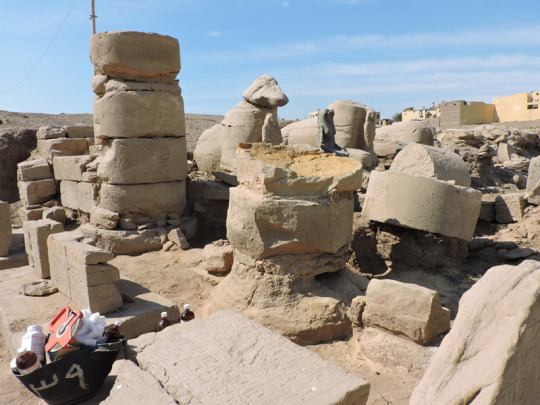
By the start of this season, little was left of the upper block, so the restorers’ first task was to clean up the base and remove the sand from the upper block so that what is left could be consolidated. This photo shows the state of the column on February 4.
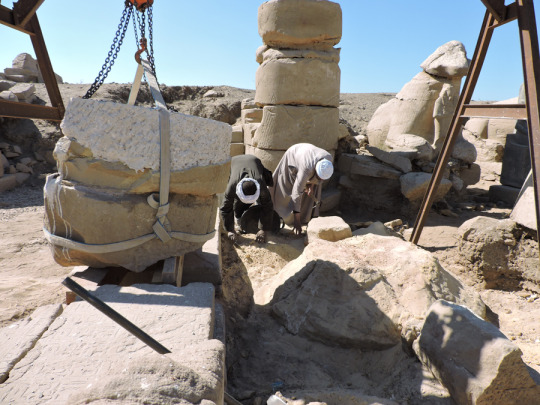
The next step was to build a form to fill in the missing part of the upper block to a uniform height. Then both column drums were moved onto a temporary platform so the base could be cleaned. It, too, had largely turned to sand, so Mamdouh went to work to clear the sand down to solid stone.
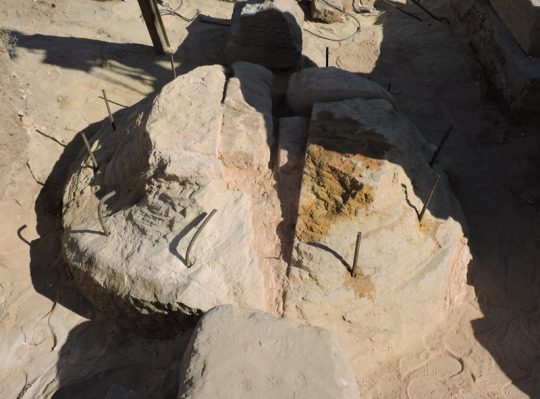
This is the condition of the column base on February 15, our last day at the site. Interestingly it is made up of several small blocks rather than the usual pair of semi-circular blocks. The metal bars will reinforce the fill that will bring the base up to a proper level.
Work on both columns will go on after we have gone. When the repairs are complete, Abdel Aziz will send us photos that we will post to show the result of their efforts. The work is expected to take another 10 days, so there will be something of a gap between this post and the final one of the season.

On Sunday Mary spotted this painted lady butterfly near where we are working, the first we’ve ever seen at Mut. Only a few inches across, this small creature migrates across the Sahara Desert every year. Amazing! We thank our niece, naturalist Rosemary Mosco, for identifying it for us.
Posted by Richard Fazzini and Mary McKercher
#BkMMutDig#MutDig#Brooklyn Museum#art#excavation#Egypt#temple#BkMEgyptianArt#archaeology#brooklyn#museum#sahara desert#amun#column#limestone
88 notes
·
View notes
Photo

Abdel Aziz and the conservators finished their work on the columns in the Mut Temple’s porches on March 7. This photo and most of the others in this post were taken by Abdel Aziz in the final stages of the work and at the end. If you compare this shot with the next picture (taken some years ago), you’ll see what a difference their work has made. We are incredibly fortunate that they were willing to take on this project. And we are most grateful to Abdel Aziz for taking all the photos for the last few posts.

Just a reminder that this is what the porches looked like before the 2023 season, with fallen column drums lying helter skelter in the East Porch and the collapsed column blocking the view of the rams near the West Porch.

On March 4 Ayman supervised the lifting of what should have been the final column drum in the west column. It turned out not to fit, no matter how they tried, so it had to be taken down and left beside the column.
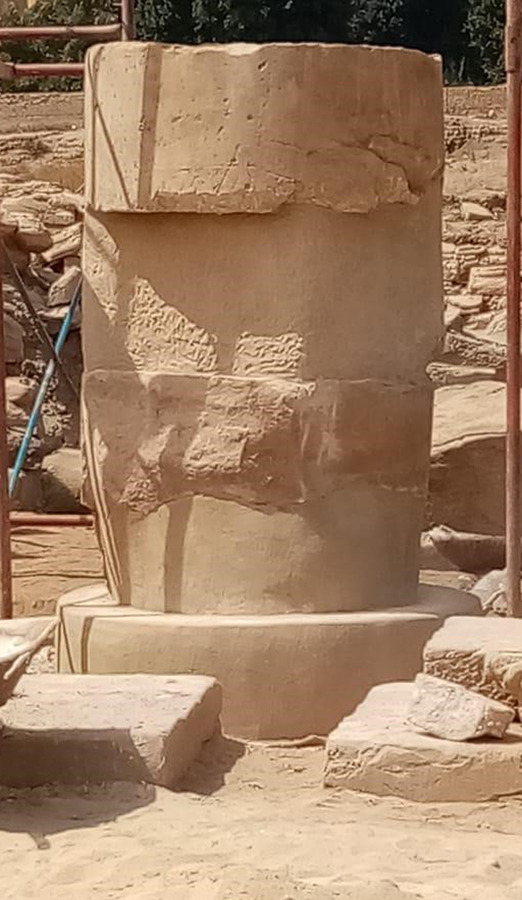
By March 6, the west column was finished. It looks much better than it did at the start of the season, when it was pretty much a heap of sand. Now at least you can tell it is a column.

This is the West Porch on March 7, with the column restored as much as it could be and the whole area cleaned up.

And here is the East Porch on March 7. While there are still miscellaneous column fragments that can’t be put back in place, the porch is looking much more organized.
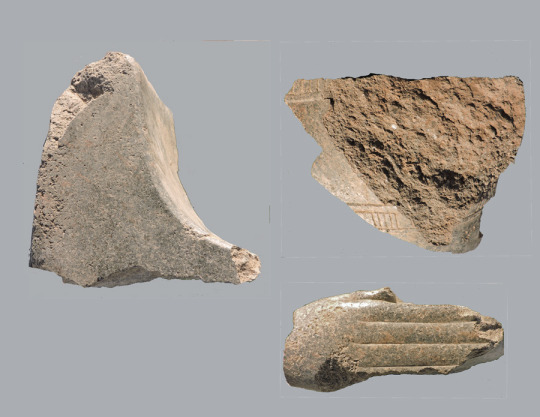
A leftover piece of business from our shortened season. While working in the north square in Temple A, we uncovered these three pieces of diorite (not to scale): the back of a throne (left), part of a torso (top) and a hand. On the torso fragment you can just make out the bandeau at the bottom that ran under the breast and part of the broad collar at the top left.

It wasn’t until the season was almost over that we realized the fragments came from the lone Sakhmet statue on the north side of the court – why we didn’t think of this immediately we don’t know. The hand and throne fragment fit easily, but the statue’s torso was too damaged for the breast fragment to be reattached. When they finished with the columns, the Egyptian conservators re-attached the hand and throne back, and left the torso fragment sitting on the statue’s lap.
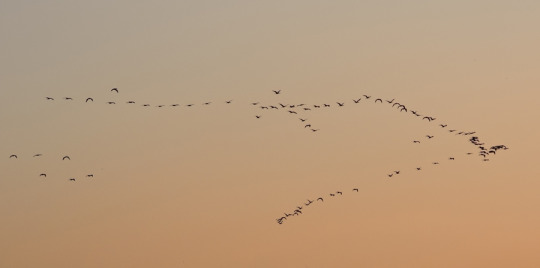
Almost every evening around sunset we watched huge flocks of ibises fly north. We don’t know where they came from or where they were going, but the flights were beautiful.

We close this last post of our last season with a view of the moon setting over the Nile. We will miss the beauty of this place as well as the people there we have come to know and love.
Posted by Richard Fazzini and Mary McKercher
#BkMMutDig#MutDig#Brooklyn Museum#art#excavation#Egypt#temple#BkMEgyptianArt#archaeology#brooklyn#museum#column#nile river#full moon#ibises#sakhmet#diorite
57 notes
·
View notes
Photo

The only approach to the Mut Precinct is along the avenue of rams built by Nectanebo II (362-343 BC), the last native Egyptian pharaoh. The sandstone paving is original, even if somewhat worn and broken. Pretty amazing when you consider that it is about 2,400 years old.

As he promised, Abdel Aziz has been sending us regular updates on the column restoration project. By February 21, the work on the east column was in its final stages. As you can see here, the semi-final coating, toned to match the sandstone, has been applied. The herringbone pattern of grooves is to allow the final coat to adhere. A worker, wearing the protective gear, is using a grinder to smooth the surface of the lower column drums cut by Sayyid. The lowest column drums of most columns curved out from the column base, mimicking plants. The worker is grinding the new stone to match the ancient shape.

By February 27, the east column was finished. This is the better-preserved east side of the column.

The other side of the column was in worse condition and essentially had to be rebuilt. The missing parts have been filled in so that it is now complete and stable. Originally there were thin walls between the columns (called “intercolumnar walls”), their junction with the columns marked by a projection on the lowest column drums. The restorers have mimicked this feature on the restored column. Talk about attention to detail.

In our last post on-site, the base of the west column had just been cleared of the deteriorated sandstone. By February 21, a new base had been constructed and one of the restorers was creating a new support for the column drums using baked brick and a cement mixture. We used a similar method to create new bases for the smaller columns in Temple A that we restored in 2019.

It takes time for the cement to cure properly, but by February 27 the two ancient column drums had been mounted on the new column base and the scaffold had been set up, ready to lift the remaining drums into place. Stay tuned for the final installment.

One big attraction for tourists is a dawn balloon ride over the monuments on the west bank: Deir el Bahari, the Valley of the Kings, the Ramesseum and Medinet Habu. We saw as many as 21 balloons at a time this year.
Posted by Richard Fazzini and Mary McKercher
#Brooklyn Museum#brooklyn#museum#bkmconservation#Egypt#BkMMutDig#Mut#temple#excavation#BkMEgyptianArt#archaeology#column#MutDig
45 notes
·
View notes
Photo
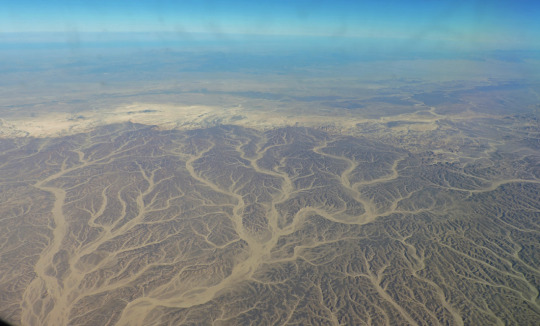
We flew from Cairo to Luxor on January 24. The flight took us over the eastern desert between the Nile and the Red Sea (just visible in the background). While it is bleak and barren now, 10,000 years ago the area was lush and green with many complex river systems. All that is left of them now are the river beds, filled with sand.

The rear of Temple A, completely overgrown with a spiky plant with shallow roots known as camel thorn. Controlling encroaching vegetation is a constant challenge in Luxor as the plants and their roots can damage the monuments. Before we can begin any work the grasses and camel thorn have to be removed, which is a challenge. This photograph and those that follow were taken by our foreman, Abdel Aziz Farouk Sharid, whom you will meet next week.
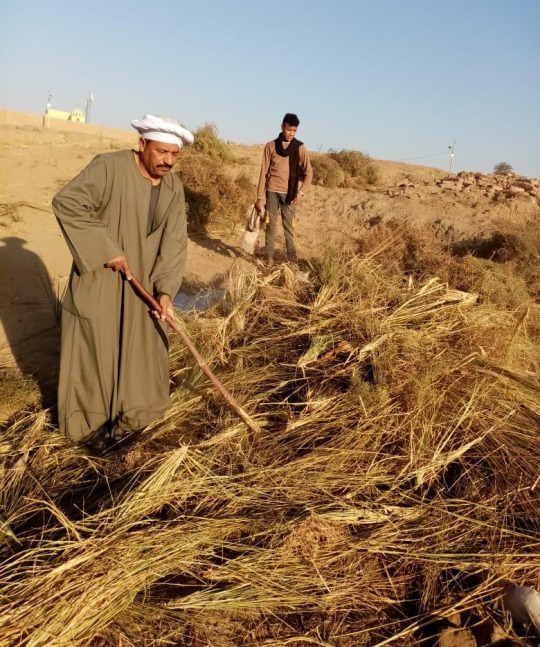
Halfa grass is a very tough, hardy plant with an extensive root system that can grow through cracks in stone and cause severe damage. Before we can even begin to work, the halfa and camel thorn have to be cleared, which takes about 10 days – it’s a big site! Fortunately, Abdel Aziz got started well before we arrived so that we may begin work on Saturday.
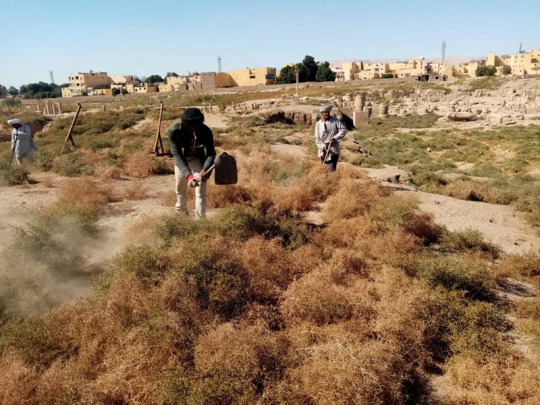
Camel thorn is a real pain to deal with! The spikes are very sharp.
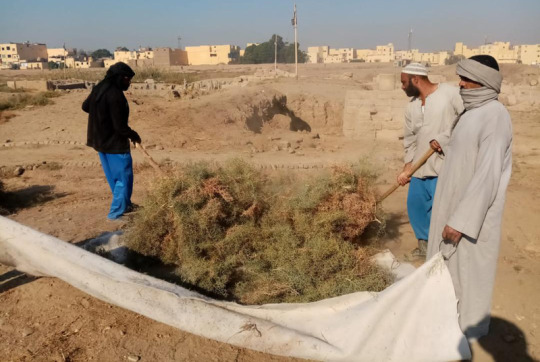
The halfa grass can simply be bundled up and removed. Camel thorn is another matter. It has to be raked carefully onto a sheet of canvas so it can be removed without cutting the workers. We are most grateful to them all for undertaking this annoying and sometimes painful work.
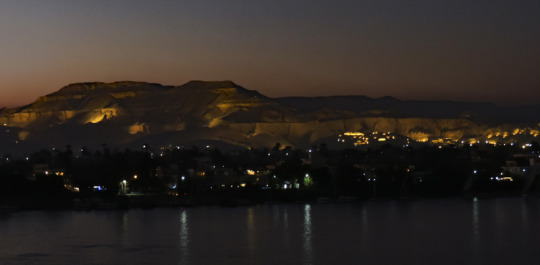
Our first night in Luxor on January 24 we sat on our balcony and watched as the Theban cliffs were illuminated. Day or night, the view across the Nile is spectacular.
Posted by Richard Fazzini and Mary McKercher
#BkMMutDig#mutdig#mut#dig#excavation#Egypt#BkMEgyptianArt#egyptian#egyptian art#cairo#nile#temple#halfa#camel thorn#luxor
52 notes
·
View notes
Photo
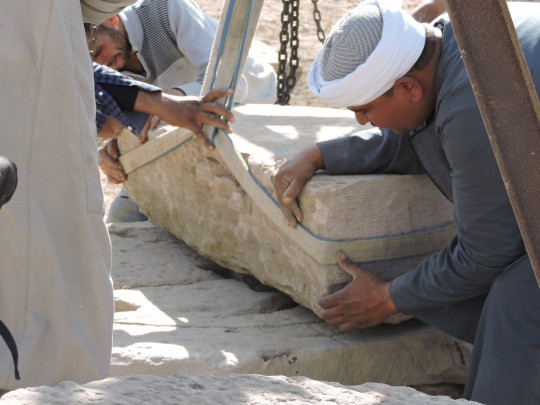
This week’s Dig Diary will be mostly about restoring the column in the Mut Temple’s East Porch. The work is painstaking and requires skill and concentration, as you can in the faces of Abdel Aziz and Mohamed Jad. But we’re getting a bit ahead of ourselves.
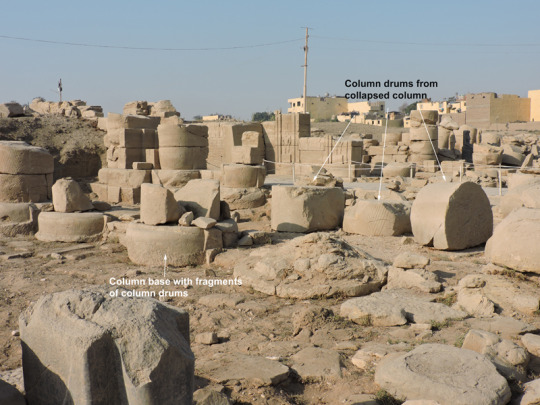
Last week we showed you the fallen column in the East Porch. We eventually had to move the column drums to excavate beneath them, so this is how the area looked until this year.

On January 30, Mr. Sa’adi Zahi Abdullah, head of restoration for Luxor/Upper Egypt (left); and Mr. Mohamed Jad Ahmed Jad, head of restoration for Karnak (beside Sa’adi), came to the site to study the column to see if restoring them was feasible. They agreed it could be done and have undertaken the project.

First we had to remove the fragmentary column drum from the base and clean up the area around it so that the restoration work could begin. Like many ancient Egypt columns, the base is made of two semi-circular blocks, which are easier to deal with than large, round ones.
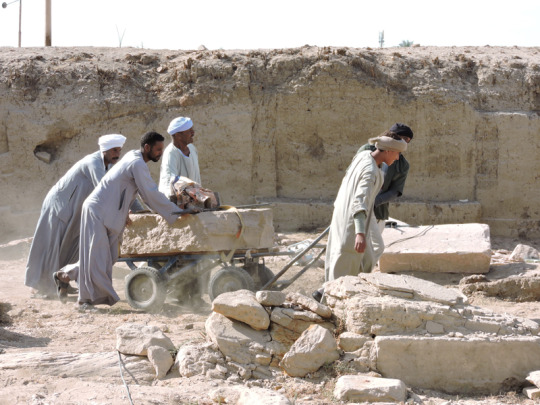
The lowest column drum in the East Porch is missing, so new rectangular stone blocks were brought in from East Karnak. (We thank Mustapha Saghir, SCA Director for Karnak, for making this stone available to us.) On Sunday morning, a truck brought the stone to the precinct gate, but from there it had to be wheeled in by hand.

Master stonemason Sayid Ahmed Mohamed Sebbak and his assistant use both an electric saw and a hammer to rough-cut the blocks to approximately the right size. Then Sayid used a string and pen to scribe the diameter of the finished block.
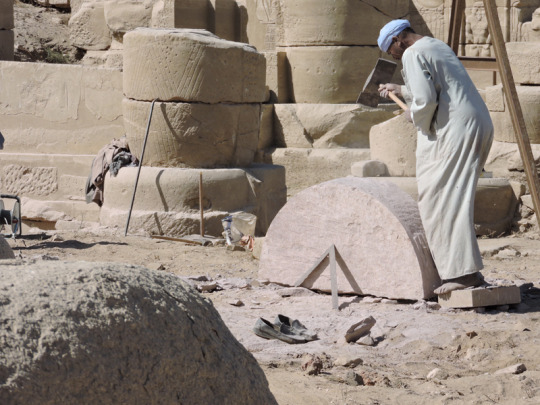
Using only a heavy, toothed chisel, Sayyid shaped the rough block into a precise semi-circle. This is all done by eye. With the right angle (leaning against the block) he makes sure that the corner where the straight edge of the block meets the top and bottom is precisely 90°. Modern Egyptian stonemasons are every bit as skilled as their ancient counterparts.
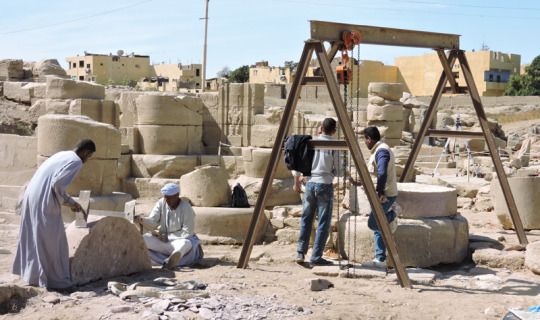
By noon on Sunday, both halves of the new column drum were in place and Sayid was almost ready with the first stone of the next course. The blocks are lifted into position using a siba: a winch supported by a metal framework along with the blocks can be moved.
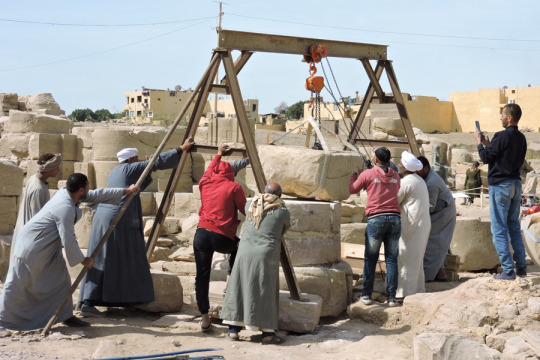
By the end of the day on Monday the second new column drum was in place. Getting the first of the ancient column drums up was more of a challenge as it probably weighs a couple of tons and is not exactly easy to move. In fact, it was so heavy that the siba had to be reinforced by another metal bar, being held in place by one of the workmen.

By now the column was too tall for the siba, so on Tuesday the conservators and workers built a scaffold to lift the remaining blocks. The third ancient block went up on Wednesday morning.
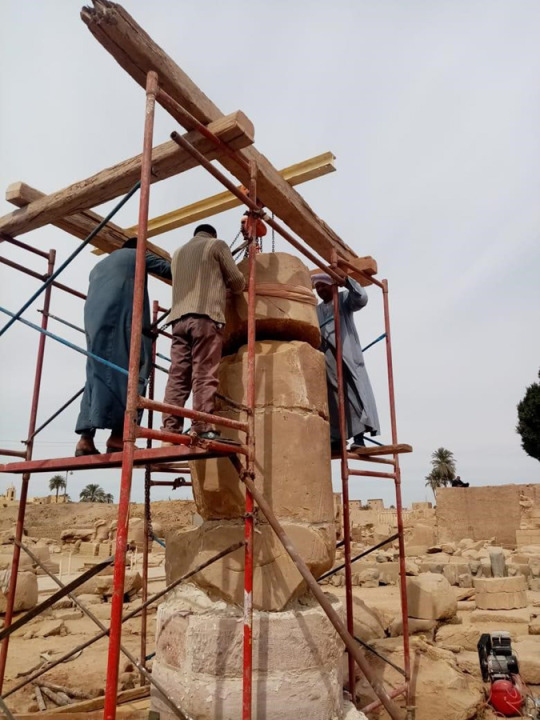
And the fourth block was lifted into position on Wednesday afternoon after we had left for the day. We thank Abdel Aziz for this photograph of the block being lowered into place. As you can see, some of the blocks are quite damaged. They will be repaired once all the column drums are up.
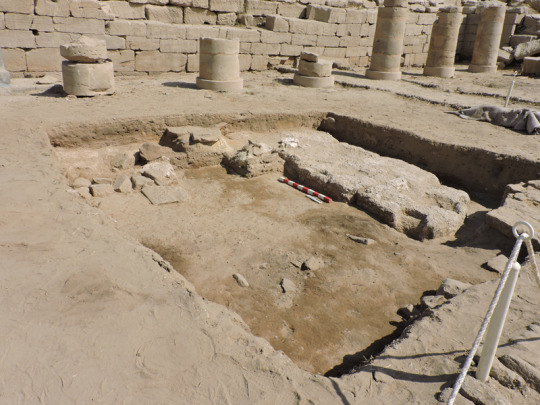
While all this was going on, the digging continued. In the north square, Mamdouh has cleared all the limestone rubble and we can now definitely confirm that we have a sphinx base. You are looking northeast across the square as it was on Thursday afternoon. The sphinx base is clear, and we have later sandstone paving in the southeast corner and just to the west of the limestone. A second patch of limestone is appearing in the northwest corner of the square, but we don’t know what it is yet.

Ayman has cleared the corridor for much of its length, as you can see in this view to the east. Regrettably no paving or flooring is preserved, the whole space being filled with broken sandstone and limestone blocks, some decorated but most not.
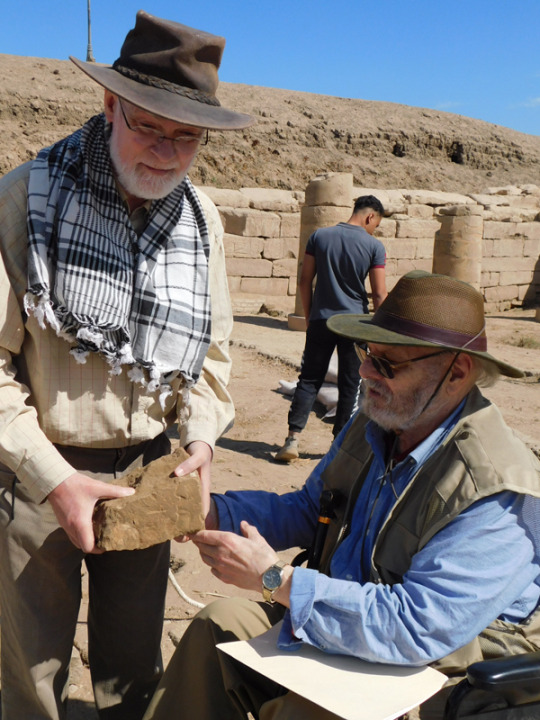
Jaap is holding one of the blocks from the corridor, showing the lower part of a face. He and Richard are discussing the sculpture’s date; they have not come up with a decision yet.

This is the view of Karnak that we see every day as we walk to work along the avenue of rams. The whole expanse of Karnak is now visible, from the First Pylon on the left to the southeast corner of the enclosure (just out of the shot – sorry). It’s a spectacular view!
Posted by Richard Fazzini and Mary McKercher
#Brooklyn Museum#brooklyn#museum#MutDig#BkMMutDig#Mut#dig#temple#BkMEgyptianArt#Egypt#excavation#egyptian art#archaeology#stonemason#sphinx
52 notes
·
View notes
Photo

Dig Diary, February 17, 2019:
Jaap van Dijk and Julia Harvey were not able to join us for the season, but they arrived for a short visit on February 14. While they talk about what is happening on the south side of the court, work on the columns continues behind them.
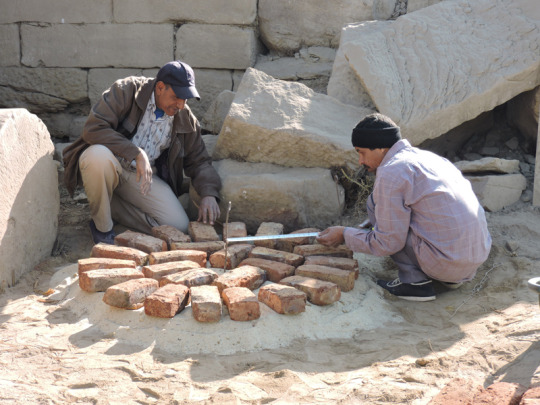
How to build a round column base using rectangular bricks. It takes careful measuring and placement. This is the new base for the column whose original base we discovered last week and had to cover again.

By February 9 the new base was finished, but it had to cure for another day.
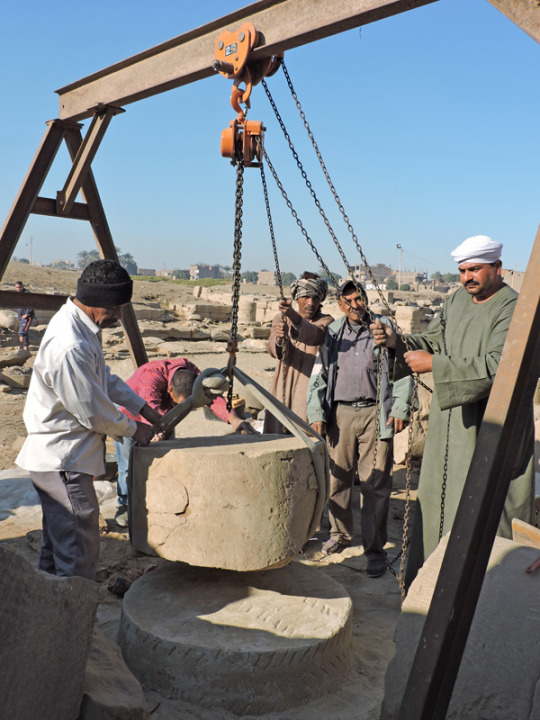
The first column drum is moved onto the new base. We are using a new and better siba (support and winches) this year, one that allows the column to be lifted and moved horizontally in one operation. It’s a big improvement on the old tripod siba we used in the past, which had to be repositioned constantly to move blocks.

On February 12 the third column drum was lifted and lowered into place.

Using a crowbar Salah and Anwar gently shimmy the column drum into its final position. It takes both skill and patience to move the block that last few centimeters without damaging the stone.

Only half of the fourth column drum was left and it broke in two pieces while being moved. Salah perches on top of the column while waiting for the upper piece of the last drum (being carried by the three guys in the foreground – sandstone is heavy!) to be winched into place.

By the end of work on Thursday, both columns were back in place. Next week we will tackle the heap of column drums in front of them, in the hopes of being able to rebuild a third column.

People sometimes ask how ancient sites can disappear. One answer is wind, as these two statues demonstrate. Maurice Pillet, the French archaeologist who excavated Temple A in the 1920s, repaired the left statue and set both up on paving in front of the second Pylon. In the intervening 90-odd years, almost 50 cm of windblown dirt accumulated over them and over the whole court, including the column base Richard wrote about last week. Imagine what 1,000 years of blowing sand and dirt can do, particularly when combined with pillaging by people looking for useable materials like brick and stone.
Once we had the bases fully exposed, we realized that the statues are both too heavy and too fragile to be moved safely, so we will have to leave them where they are.

It’s not totally hopeless, though. We can at least put the upper half on a small platform (called a mastaba), under construction at the left of this photo. We have also built a baked brick wall around the area of the two lower halves in hopes of preventing them from being reburied.
In the foreground is the rear part of the sphinx we moved last week. Its broken pieces have been reattached and await their final restoration.

While the conservation work was going on, we continued excavating the south side of the court. Shergawi Abbas, another Qufti, joined us this week and immediately began work on the Nitocris chapel.

By the end of the week the chapel had been completely cleared and we were able to see the paving in its front room for the first time.

In the meantime, we finished up in the central area. Here you are looking west to the second Pylon from the Nitocris chapel. The north (front) edges of the limestone rectangles clearly appear to line up, suggesting that they are indeed the bases of sphinxes that were dismantled down to their foundations at some point. The foundations then served as the floor for the other structures built in the area.
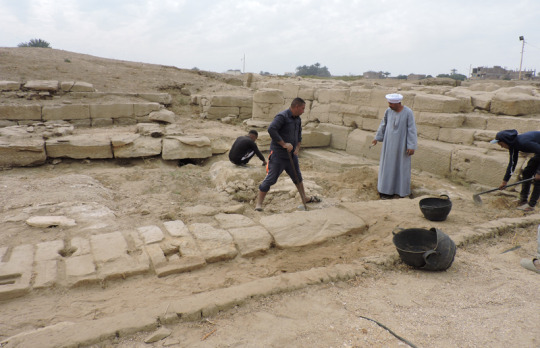
With work in the central area done, Ayman began to clear the windblown earth off the western area, where we first found limestone rectangles/sphinx bases in 1996. We have no idea what kind of a structure the blocks forming the north border of the area came from. All have round holes with channels. Perhaps they were originally the foundations for a temporary structure and were re-used when that structure was no longer needed. We will probably never know.

I’m afraid there won’t be any pictures of birds in the sacred lake this year. The reeds have taken over almost completely, and there are only a few spots now where you can even glimpse the water.
Posted by Mary McKercher
#bkmmutdig#mutdig#dig#archeology#brooklyn museum#egyptian art#egypt#luxor#bricks#siba#construction#stone#columns#sphinx#excavation#mastaba#restoration#qufti#nitocris#limestone#foundation#wind#highlight
446 notes
·
View notes
Photo
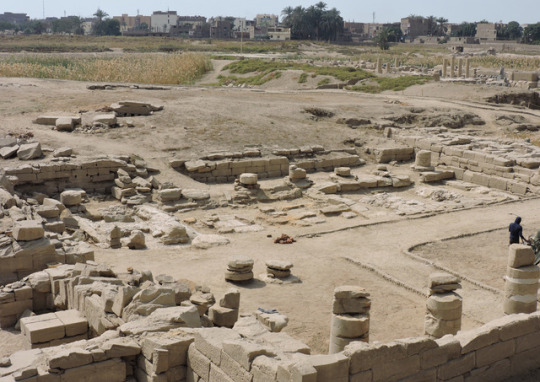
Dig Diary, March 10, 2019:
This is the final post of the season and includes the results of work that took place after we left Luxor. This picture of the whole of Temple A’s 1st Court was taken on February 23, our last day at the site. The Mut Temple and the east arm of the Isheru (sacred lake) are in the background. After we left, Abdel Aziz and a small team continued the restoration work. The pictures that follow were sent by Abdel Aziz between February 24 and the 28th, when all the work ended.
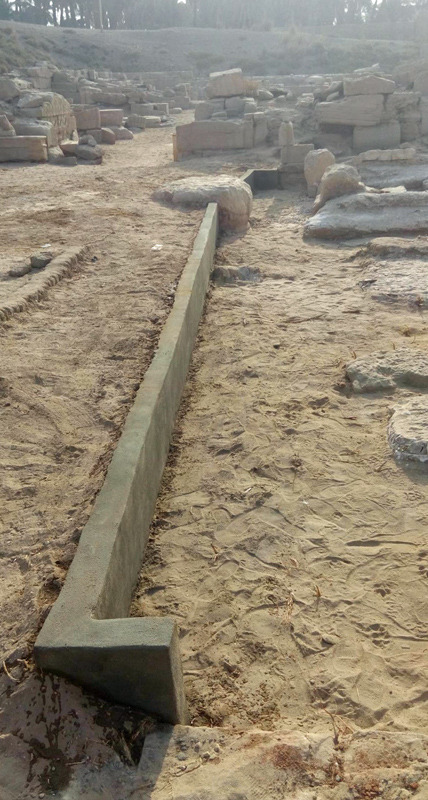
At our request, Abdel Aziz and crew built a brick wall along the north edge of the area excavated this year in hopes of preventing dirt from crumbling into the area. This is the penultimate phase; the cement was coated with a final layer of color to match its surroundings more closely.

Salah applies a thin coat of mortar tinted to match the sandstone. The repairs to the columns themselves have been similarly treated.

Looking west along the front (left) and back of the north colonnade on February 28. It now looks like a colonnade rather than a pathetic collection of fallen and tipped column drums. The Sakhmet that Salah and Mohamed Abdu restored last year is visible in the righthand picture. Thank you Abdel Aziz, Ayman, Salah and Anwar for all your hard work!
Posted by Mary McKercher
#bkmmutdig#mutdig#mut#dig#archeology#brooklyn museum#egyptian art#egypt#egyptian#excavation#restoration#dirt#sandstone#colonnades#sakhmet#mut temple#temple#isheru#sacred lake#luxor#dig site#archeology site
115 notes
·
View notes
Photo

Dig Diary, February 24, 2019:
The season ended on February 21. We got an incredible amount done in just three weeks.
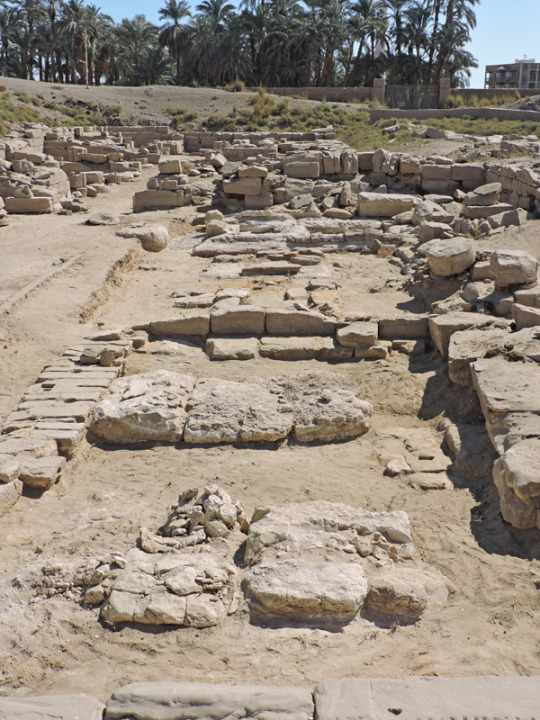
Here you are looking east across the south side of Temple A’s 1st Court, which has been completely cleared for the first time. The next few pictures will give you a more detailed view.
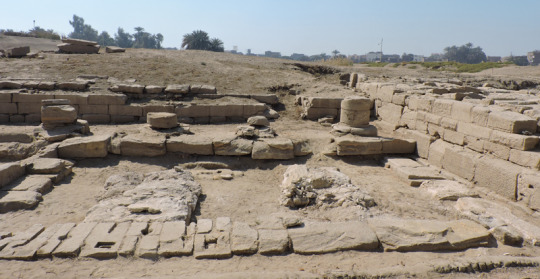
The limestone sphinx bases we saw for the first time in the 1990s are now visible again along with the walls built over/around them. There is even a patch of original paving (rear) between the base on the left and the one on the right. It is impossible to date any of this precisely, but we can at least determine the sequence of construction. The sphinx bases are the earliest feature as the one on the right was cut by the construction of the 25th Dynasty 2nd Pylon. The south wall, which abuts the footing of the colonnade, sits on several centimeters of earth above the limestone and rides over the lip of the pylon, so it was built after the pylon was completed, that is, no earlier than late Dynasty 25. The east wall is part of the same structure as the south wall and sits on top of another sphinx base.

You are looking southwest across the central area, which we excavated this year. The small structure against the west wall of the area (right) may be a small chapel. What the square feature in the foreground is we will never know. Both appear to be built on the remains of the row of sphinx bases. The wall dividing the area into east and west was cut back to accommodate the north wall of the chapel(?), so it is either contemporary with or slightly later than the western structure.
As well as excavating the area, we neatened it up by straightening up the column drums in what is left of the colonnade along the south side of the court (background).

The Nitocris chapel at the end of the season. Attributed to her on the basis of a lintel found nearby, it was presumably built in Dynasty 26, and is thus the only datable structure on the south side of the court. Earlier in the season we discovered the broken block that formed the east doorjamb, with its granite pivot. We put it back in place so that the chapel now has a doorway in roughly its original position. While we couldn’t excavate the rear room, we have at least leveled the pair of raised sandstone blocks against the south wall and put the eastern column drum (left) back on its base.

Here’s another view of the chapel looking north. Once we had cleared the first two rooms, we laid down sheets of plastic and covered them with sand and a layer of gravel in hopes of inhibiting the growth of weeds and grass. The doorjambs and their door pivots are a bit clearer in this picture.

Once all the excavation was done, Mary began to map the area. It’s a fussy and time-consuming task, but has to be done.

On February 16, I noticed this gaping hole in the lowest course of the court’s north wall, whose reliefs depict the birth, circumcision and presentation of Taharqa to the gods. This is one of the most important relief sequences at the site, so repairing the wall became an instant priority. There was a similar but smaller gap nearby in the 2nd Pylon.

By February 20, Salah and Anwar had repaired both areas using sandstone blocks. The surface will be coated with a layer of mortar tinted to match the original stone after we leave – we just ran out of time.

On February 17, the torso of the Ramesside statue was lifted out of the dirt and placed on its new mastaba.
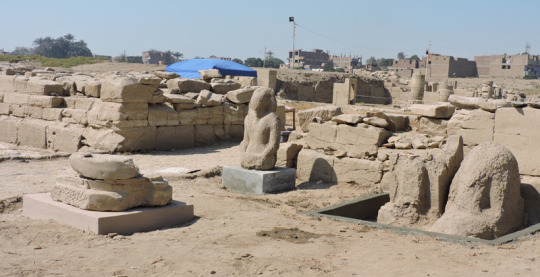
The three pieces of the statues and the rear half of the sphinx at the end of the season. They are now at least somewhat protected against encroaching dirt and dampness.
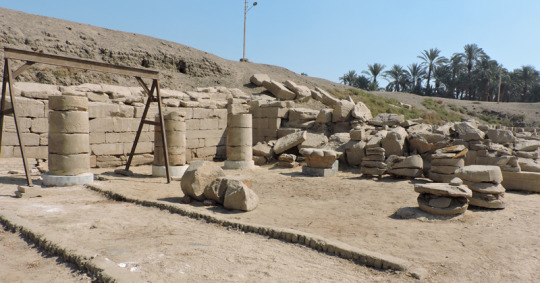
We had originally planned on re-erecting only the two eastern columns on the north side of the court, but concluded that we could use the blocks from the disorganized heap of column drums Mary described last week to build a third column. This column’s base was partly covered by the pathway leading to the Taharqa circumcision scene, one of the most popular features of the site. We had to cut the path back a bit, but it was worth it to get this column back in place. We’ve also generally cleaned up the area, including putting an elaborate column capital up on a mastaba. Pillet had left it with its decorated side facing the 3rd Pylon and thus hidden from view. It is just in front of the column on the right.

Here’s a view roughly northeast along the complete colonnade on the court’s north side. All the columns are now in their proper locations After we leave, Salah and Anwar are going to build new bases for the 4th and 5th columns from the left, which are now just sitting on bricks.
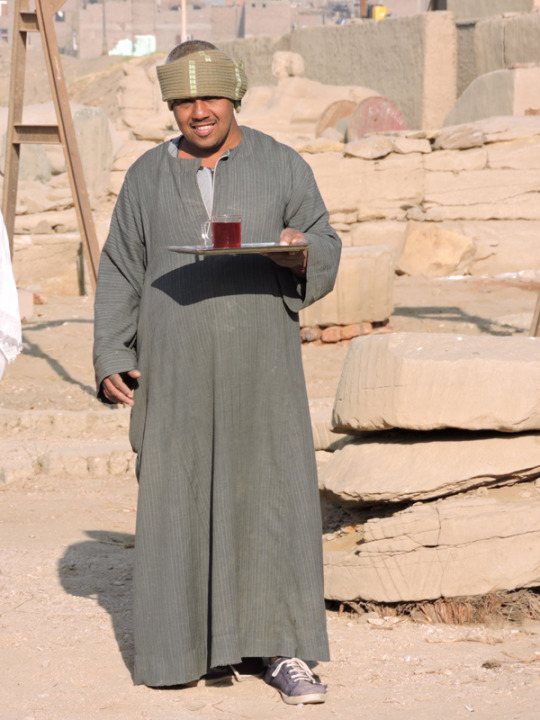
Before I leave you, I want to introduce one more important member of the team: Ezadin Mohamed Abdel Razik. Eza keeps us supplied throughout the workday with hot tea and karkadeh (a drink made from hibiscus blossoms). This may sound minor, but hot tea is very welcome on cold mornings, and karkadeh is very refreshing in the heat of the day. Eza is also a very cheerful and conscientious person.
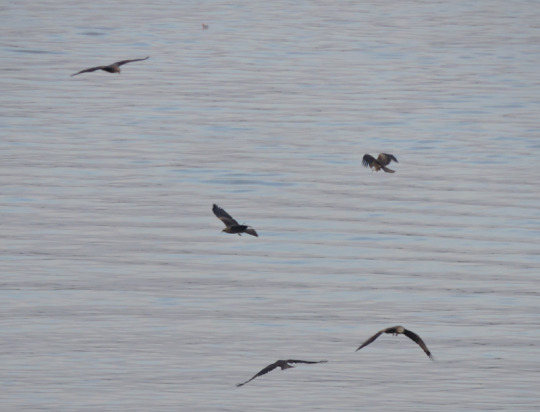
On Thursday morning we saw a large number of harriers (I think- we need Jaap to tell us for sure) scavenging on the surface of the Nile.
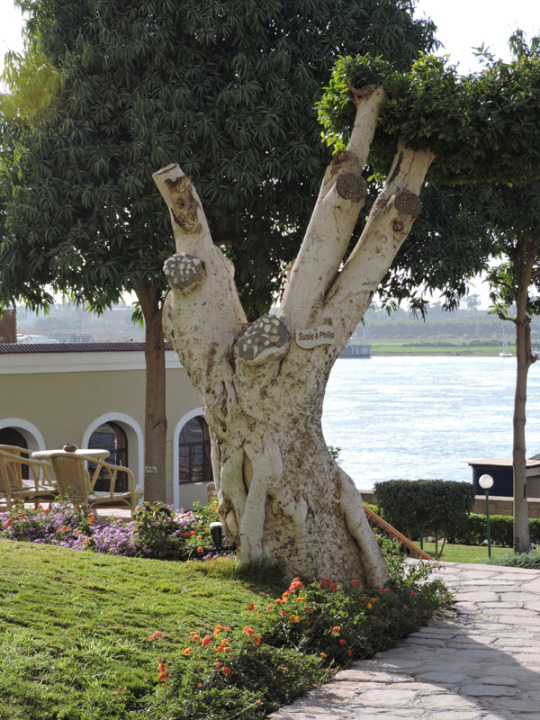
For some reason, a few of the trees in the hotel garden have been severely pruned and the spaces where large branches used to grow have been filled with cement in which white stones have been carefully set. Each tree has a plaque commemorating a couple. No one now at the hotel remembers why this was done or who the couples were. There’s always some mystery in Luxor.
Posted by Richard Fazzini
Lead photo: Moonset at 6:20 am, February 19.
#mutdig#bkmmutdig#mut#luxor#egypt#egyptian#egyptian art#art#archeology#history#excavation#dig#dig diary#brooklyn museum#bkmegyptianart#site#sphinx#nitoris#chapel#dynasty 26#dynasty 25#Taharqa#Ramesside#statue#mastaba#karkadeh
111 notes
·
View notes
Photo

Dig Diary, February 12, 2018:
We finished the new retaining walls and stairway down to the Thutmoside gate on February 6. We installed a post and rope barrier around the area for the safety of visitors as the excavation is quite deep. At last people will be able to get a close look at this important monument, one of the earliest standing structures in the Mut Precinct.

We were very lucky that Julia Harvey was willing to come again this year even though there is no pottery for her to sort. She arrived on site on February 3 and was an immense help with the final documentation and photography of the site’s Sekhmet statues. Here she is dusting off the lap of the large and famous statue in the Mut Temple’s 2nd Court so I can photograph it.

In 2001 we painted inventory numbers on all the Sekhmet statues then visible at the site. On February 6, Julia and I added numbers to the statues found since then but not numbered. The tools of the trade for documentation: brushes to clean dust off surfaces about to be photographed or numbered, a mirror to cast good light on inscriptions, and paint for numbering. On the right, adding its number to the large statue Julia dusted a few days ago.

Speaking of Sekhmets, Jaap found two pieces of a Sekhmet inscription lying on the mastaba (platform on which stone blocks are kept) at the front of the precinct. It only took him a few minutes to realize that they belong to a badly damaged statue in the Mut Temple’s 1st Court. Incredibly, he also found a fragment of the statue’s base nearby; the pieces fit perfectly! Congratulations, Jaap!

Most of the effort this week has centered around the restoration of the Sekhmet statue in Temple A. Putting the two sections of the base together was the most nerve-wracking as the stone remains fragile even after consolidation. On the left, Mohamed Abdu pours epoxy into the holes in the rear part of the base to hold the stainless steel rods once the two pieces are joined. Then comes the painstaking effort to lower one piece onto the other. Breaths were held all round.

The two pieces are almost together (left), after careful adjusting to make sure everything lines up properly. Once the pieces were in place, Salah Salim (left) and Mohamed Abdu (center) filled in the cracks in the join. They are justifiably proud of their work, as is Ayman Farouk Sharid (right), the Qufti who is working with them.

Even though the block of stone is much larger, putting the body of the statue onto the restored base was child’s play by comparison to fixing the base. The two pieces were joined, aligned and attached over the course of work on February 5.
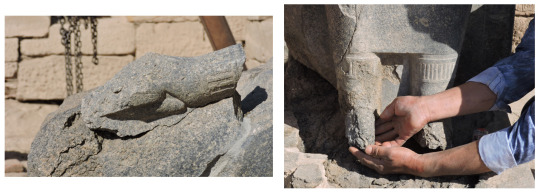
Much to our delight on our last day of work (February 7), I found Sekhmet’s left hand sitting on a block in the temple, and the conservators found her right ankle among the miscellaneous chunks of diorite nearby.
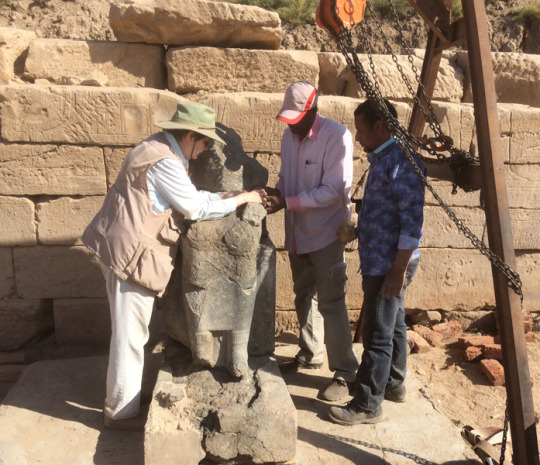
Mohamed, Salah and I check to be sure that the hand really does fit. It snapped into place beautifully.

By February 6th, the detached pieces of knee, right leg and back were in place, and on the 7th, Mohamed and Salah re-attached what is left of the statue’s torso. Now instead of just a lower half, we have an almost complete statue. Here is how she looked at the end of work. An improvised funnel on her right knee allows epoxy to be infused into a deep crack between the knees and the body of the statue.

As you can see from the picture of the statue’s right side, there is still considerable work to do to fill in the many cracks in the stone, some shallow, some deep. Mohamed has the painstaking task using an epoxy colored to match the stone. Without this infilling, moisture and dirt can infiltrate the cracks and cause further damage to the statue. He and Salah will stay on at the site to finish the work after we have gone.
Posted by Mary McKercher
#bkmmutdig#mutdig#dig diary#brooklyn museum#mut precinct#luxor egypt#egypt#egyptian art#archeology#archeologist#bkmegyptianart#statutes#dig#excavation#thutmoside#sekhmet#documentation#photography#inscription#mastaba#fragment#restoration#diorite
586 notes
·
View notes
Photo
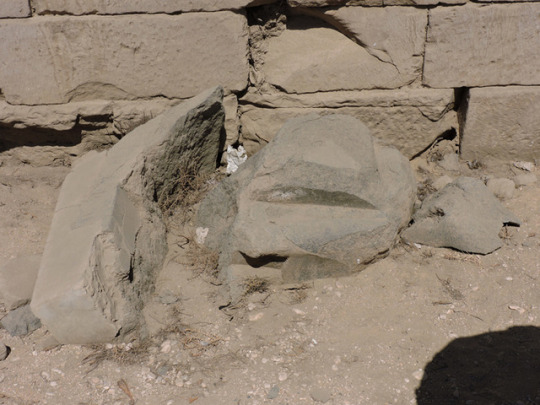

Dig Diary, March 16, 2017:
French archaeologist Maurice Pillet found and restored this Sakhmet statue in Temple A in the 1920s. Unfortunately, the restoration failed and the statue has been lying broken for decades (top). This season we decided at least to move it onto a platform to get its parts out of the dirt. Even half a Sakhmet is too heavy to be moved without help, so we brought in the siba (tripod and winch) to get the statue pieces up onto the platform.

Here it is after the move was completed. The base is lying on its side (left) and what’s left of the torso is on the right. We hope to restore the statue in a future season.
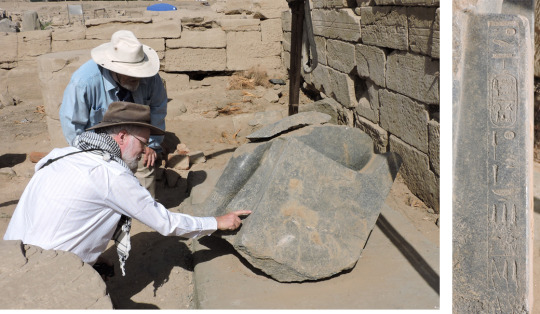
Jaap van Dijk left the dig on Monday, but before going he and I had a chance to examine the newly revealed left side of the statue. Unlike the right side, the text on the left is completely preserved. It is the standard formula of the king being beloved of a form of Sakhmet, (in this case “Sakhmet-Bastet, Mistress of her Fields”), but has never been noted or published before this.

Mary and I have spent most of this week working on the Sakhmet statues. We have been making careful measurements of each statue and noting relevant details of decoration, style, etc. The work, while very time-consuming (there are over 250 statues), is essential for us to be able to publish them properly.
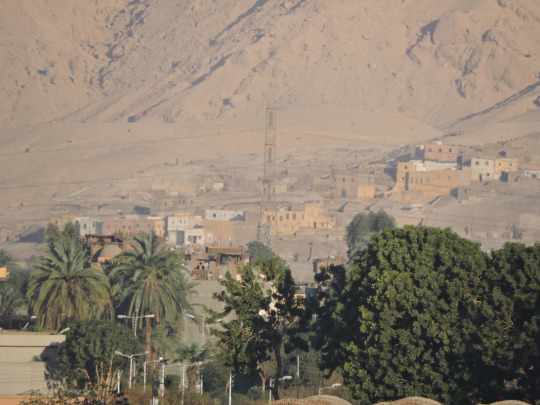
The air was crystal clear at 6:30 on Thursday morning, giving us a fine view of this village across the river in the Theban hills. It is mornings like this that remind us how lucky we are to be able to work here even for a short season. Work finishes up on Monday, so this will probably be the last post this year.
Posted by Richard Fazzini
#bkmmutdig#mutdig#dig diaries#egypt#egyptologist#archeology#archeologist#sakhmet#statue#temple#sakhmet-bastet#measurements#decoration#style#thebes#theban hills#village#brooklyn museum#brooklyn#excavation#fieldwork#mut#luxor#highlight
171 notes
·
View notes
Photo

Dig Diary, March 10, 2017:
It is very hot in Luxor right now, so the team often takes a break under the marquee that the Hopkins University team has loaned us (thank you, Betsy!). From left to right are Dr. Jacobus van Dijk of Groningen, who is studying the Sakhmet statues and their epithets with me; our senior Egyptian inspector, Mme Shemaa Mahmoud Ahmed; our second inspector, Mr. Yusuf Mohamed Ahmed; and me. Mary McKercher, of course, is behind the camera as usual.
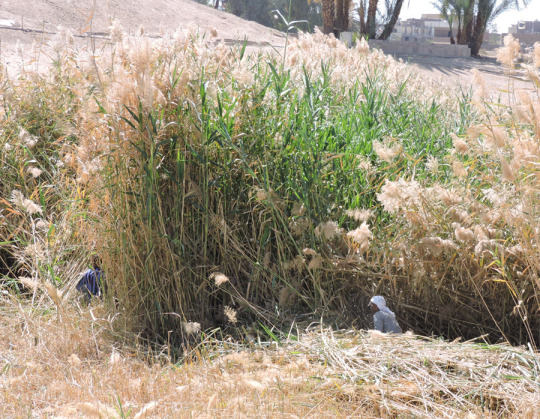
While we’re not excavating this year (the season is too short), we are carrying out a few useful, small projects. First, at the request of the Supreme Council of Antiquities (SCA) we began on March 4 to cut back the reeds that have once again taken over the northern ends of the sacred lake, particularly on the east side. You can see how thick and tall they have grown in the past year.

Our second project is to clean off the dirt that has accumulated over the past 35 years or so on a Ramesses II doorjamb that we discovered lying on what’s left of the mud brick core of Temple A’s 2nd Pylon. We’ll build a small wall around it to prevent further encroachment. We decided to remove the large undecorated block standing beside it because it obscured a re-used relief in the pylon’s stone facing.

This was no easy task as the rock is not only heavy but awkwardly shaped. However, our workers were able to get it up and out fairly quickly; they do this kind of thing all the time. We admire both their strength and their skill.

To our surprise, we found that the bottom of the Ramesses II block, which we had never cleared, was also decorated! The way the block is lying, the “new” scene, probably from the east face of the 25th Dynasty pylon, is upside down. Seen right side up here, it consists of the crowns of 2 facing figures and several columns of text. The tall plumes on the right probably belong to Amun, and the plumes and sun disk are probably a king. Unfortunately no names are preserved.

You are looking southeast at Temple A’s 2nd Pylon, built in Dynasty 25. The blocks came almost entirely from earlier monuments, including the Ramesses III temple southwest of the sacred lake, which was no longer in use. The reliefs and sculptures were split apart when necessary and their rear surfaces smoothed to form the face of the pylon. This is most obvious in the pylon’s north wing (bottom of picture) where the decay of the mud brick core has made the blocks more visible. The south wing seems to have been built entirely of stone.

Here’s a more detailed view of the inner side of the east facing. The two torsos and upside down head came from the Ramesses III temple. Other reliefs date from earlier in the New Kingdom. The relief on the left, by the way, is the one that was partially hidden by the block we moved.

At the end of a long, hot day, we sit on our hotel balcony and watch the sun set. One evening recently, this enormous flock of ibises flew by heading north. There must have been hundreds altogether.
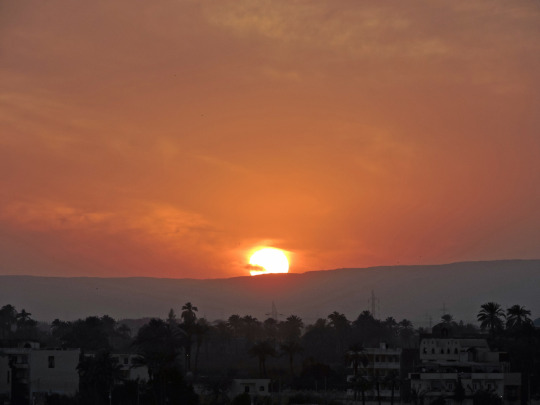
At the end of a long, hot day, we sit on our hotel balcony and watch the sun set over the Nile. It is a sight that never fails to awe and amaze us.
Posted by Richard Fazzini
#bkmmutdig#mutdig#dig diaries#brooklyn museum#archeology#egypt#egyptology#egyptologist#excavation#fieldwork#research#mut#luxor#sakhmet#statue#epithet#ramesses ii#temple#pylon#amun#sun disk#new kingdom#ramesses iii#relief#ibis#sunset#nile#highlight
265 notes
·
View notes
Photo

Dig Diary, March 3, 2017:
We arrived in Luxor on March 1 for a short study season at the Mut Precinct – and were just in time to catch a parade celebrating youth from all Egypt’s provinces. This group is performing a traditional stick-dance called “Tahtib” that began as a martial art form and dates back to the Old Kingdom.

This gentleman is one of a group of dancers who twirl huge disks of cloth while dancing below them. Their control of this unwieldy material is awesome.

And what parade would be complete without a camel?
Posted by Mary McKercher
#bkmmutdig#mutdig#digdiaries#mut#egypt#egyptologists#brooklyn museum#luxor#mut precinct#parade#youth#provinces#stick-dance#tahtib#martial art#old kingdom#dancers#performers#material#highlight#camel
35 notes
·
View notes